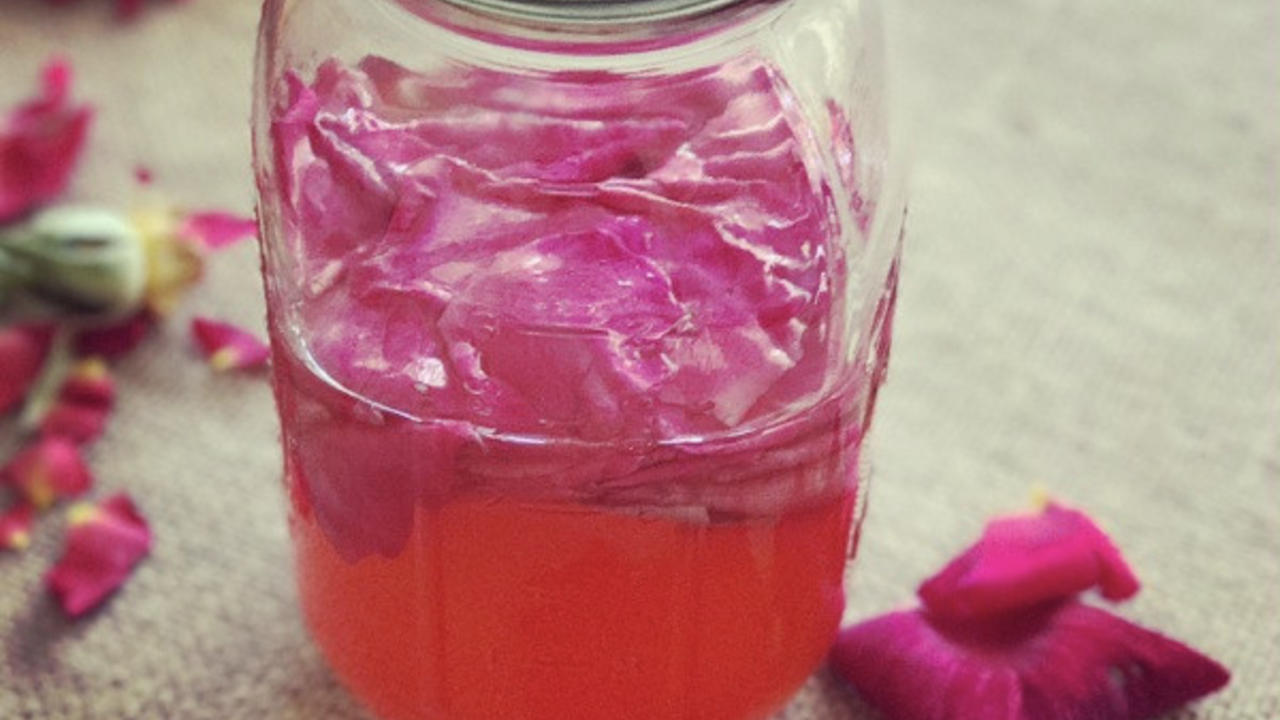Easy Rose Petal Vinegar: Your skin will drink it.

Two things sprung to mind when I spied the red roses growing outside our new country home. Rose petal jam. Rose petal vinegar. The latter won, as it turned out. It’s been far too long since I made a floral or herbal vinegar. And Spring seemed like the perfect time, with fresh salads stealing the lion’s share of the menu. Having a few novelty dressing additions on hand, never goes astray.
Flowers and fresh salads. I LOVE this time of year!
The wonderful thing about rose petal vinegar is that it’s equally at home in your bathroom cabinet and pantry. Well, to be honest, my entire beauty routine originates from the pantry anyway, so nothing special here.
Roses & vinegar: allies in beauty
As an ex-beauty therapist, I have a long-standing appreciation for roses. Their extensive list of active constituents and healing properties mean they have unparalleled scope when it comes to treating skin issues. You’ll see it recommended for dry skin, inflamed skin, acne and rosacea-prone skin, mature/ageing skin. (Yep. Virtually all skin.)

Raw apple cider vinegar is a fantastic multi-purpose skin tonic as well. Being a living food, it’s teeming with probiotics (one of the latest beauty trends), enzymes and the holy grail of skincare, the alpha-hydroxy acids (citric and malic acid to be precise).
And without wanting to sound like a skincare commercial, in my experience, it:
- Balances pH and oil production
- Wards off acne, due to it’s powerfully antimicrobial properties
- Lightens pigmentation and brightens skin tone, thanks to the AHA component
- Helps reduce the appearance of lines and wrinkles, by exfoliating the skin – without scrubbing
Making rose petal vinegar
When it comes to selecting roses for this process, it’s CRITICALLY IMPORTANT that you only use organic, non-sprayed, preferably home-grown roses. Roses from a florist are not suitable.
It’s best to opt for flowers with the most vibrant colour and aroma as they will help create a more impressive finished product.
 Simply remove the petals and place them on a plate. This helps the tiny rose-dwelling insects to exit, stage left.
Simply remove the petals and place them on a plate. This helps the tiny rose-dwelling insects to exit, stage left.- Whilst they’re on the move, select a glass jar with an airtight lid. Sterilise it by filling it, slowly + carefully, with boiling water. Allow it to stand for 5 minutes, then drain and allow it to cool. Fill the jar half-way with raw apple cider vinegar.
- Optional: According to the herbalist who showed me how to make this, the pale yellow bases of the petals can become bitter, with time. One by one, tear the bases off and place the petals in the jar with the vinegar.
 Use a clean utensil to push the petals beneath the surface of the vinegar. You can add more petals here if you wish. The higher the ratio of petals to vinegar, the more intense the resulting flavour and colour will be. Top with enough vinegar to reach the shoulder of the jar, leaving a space at the top. Attach the lid and allow it to sit in a warm spot for several days, until the colour has transferred from the petals to the vinegar. This will happen much faster in warm weather.
Use a clean utensil to push the petals beneath the surface of the vinegar. You can add more petals here if you wish. The higher the ratio of petals to vinegar, the more intense the resulting flavour and colour will be. Top with enough vinegar to reach the shoulder of the jar, leaving a space at the top. Attach the lid and allow it to sit in a warm spot for several days, until the colour has transferred from the petals to the vinegar. This will happen much faster in warm weather.- Strain out the petals and discard them. Then decant your vinegar into a suitable, sterilised glass bottle. Or if you’re happy with the current container, you can leave it, as is. If stored properly in a cool, dark cupboard, it should last several years. However, it will gradually fade with time.

Rose petal vinegar in your beauty routine
My favourite way to use rose petal vinegar is to keep it in a small glass spray bottle. I spritz it onto my fingertips and apply it to damp skin, post cleanse and prior to moisturising. Be sure to avoid the eye area, completely.
And be aware that the first few times you use it in this way, it will sting a little. If you’re yet to experience a salon ‘peel’, this is a much milder version of what they offer. Applying it whilst the skin is still damp helps to slightly dilute the acidity. However, if you have very dry, inflamed or sensitive skin, you might like to start with a 2:1 ratio (vinegar:water).
I’d love to hear your experience with this one. Have you made anything like this before? Are you already using food-based skincare? Tell me everything! :-)
